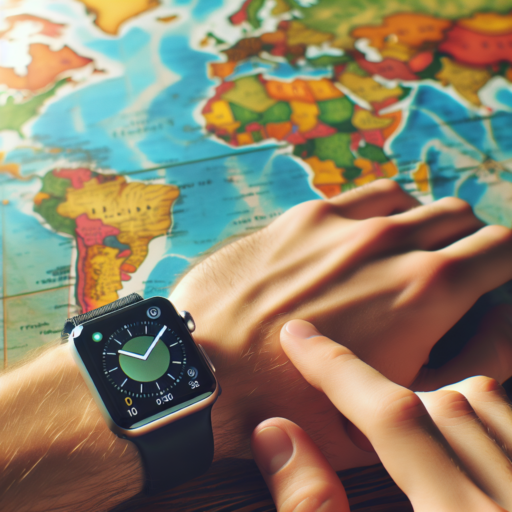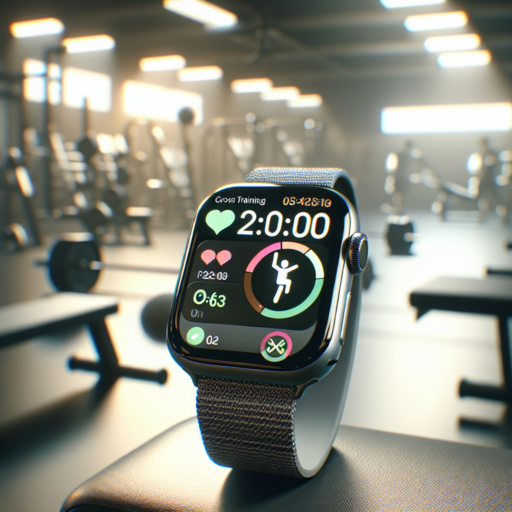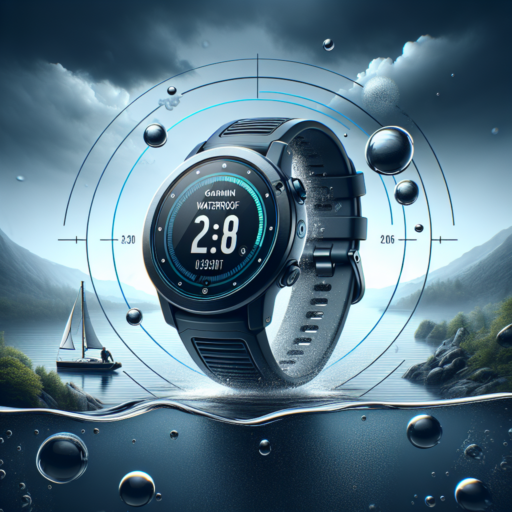What Makes Apple Watch Perfect for Navigation?
The Apple Watch emerges as an indispensable tool for navigation, thanks to its blend of advanced technology and user-friendly features. One of the core assets of the Apple Watch is its precise GPS functionality. This system ensures users can navigate with accuracy whether they’re exploring bustling city streets or trekking through remote trails. The integration of GPS with the watch’s sleek design allows for real-time directions without the need to pull out a smartphone, making the Apple Watch an ideal companion for both pedestrian and vehicular navigation.
Beyond its GPS capabilities, the Apple Watch enhances navigation through haptic feedback. This subtle yet effective feature taps the wearer on the wrist to signal turns or directional changes. Such tactile communication means eyes can stay on the road or surroundings, not constantly checking a screen. This method of interaction not only provides convenience but also significantly enhances safety by reducing distractions.
The availability of comprehensive navigational apps further solidifies the Apple Watch’s standing as a navigation powerhouse. Developers have tailored apps specifically for the watch’s interface, offering features like walking directions, public transit times, and even outdoor trail maps right from your wrist. The seamless integration and optimization of these apps with the watch’s operating system make for a smooth and efficient navigation experience, ensuring that the information you need is always a glance away.
How to Use Apple Watch for Efficient Navigation
Using your Apple Watch for navigation is not only convenient but also a game-changer in how we move around cities and unfamiliar territories. The compact device on your wrist is more powerful than it looks, offering detailed directions and a range of features to make your travels smoother. In this guide, we’ll explore some key functions and tips to leverage your Apple Watch for the most efficient navigation experience.
Setting Up Your Route
Start by ensuring your Apple Watch and iPhone are synced and that you’ve enabled location services for Maps. To set up a new route, you can either ask Siri directly on your Apple Watch or use your iPhone to input the destination. Once the route is active, your Apple Watch will gently tap your wrist with distinctive patterns to signal turns or changes in direction, allowing you to focus on your surroundings rather than constantly looking at a screen.
Using the Compass and Maps App
The Compass and Maps apps on your Apple Watch are invaluable tools for navigation. The Maps app provides a clear view of your current location, directions to your destination, and estimated arrival times. For more interactive guidance, use the Digital Crown to zoom in and out of the map. The Compass app, on the other hand, gives you real-time orientation, showing which direction you’re facing. This can be especially useful in heavily wooded areas or when navigating large buildings.
Remember, the efficiency of navigation using your Apple Watch greatly relies on how well you leverage these features. With practice and familiarity, you’ll find navigating with your Apple Watch to be a seamless and highly useful aid in your daily travels and adventures.Comparing Apple Watch Navigation with Traditional GPS Devices
When discussing navigation technology, the comparison between the sleek, modern Apple Watch and traditional GPS devices becomes a topic of keen interest. While the former represents the pinnacle of wearable technology, integrating seamlessly into our daily lives, traditional GPS devices are known for their robustness and specialized features. This exploration delves into their functionalities, user experience, and versatility to provide insights into their navigation capabilities.
Functional Differences
The Apple Watch brings a level of convenience to navigation that is hard to match. With its haptic feedback, users receive subtle taps on their wrist to indicate directions, making it less obtrusive and more accessible especially when in transit or busy cityscapes. On the other hand, traditional GPS devices are designed with a focus on navigation, providing real-time updates, detailed maps, and sometimes even topographical data which are pivotal for certain outdoor activities.
User Experience
User experience in navigation significantly diverges between these two technologies. The Apple Watch prides itself on its intuitive interface, allowing users to quickly glance at their wrist for directions. This is complemented by Siri’s voice assistance for hands-free interaction. Conversely, traditional GPS devices often feature larger screens with detailed displays, catering to users who prefer a comprehensive view of their routes and surroundings. Their user interface, though not as streamlined as wearable technology, typically offers more in-depth customization and options tailored for specific navigation tasks.
Versatility and Adaptability
When it comes to versatility, the Apple Watch demonstrates its prowess by integrating various functionalities beyond navigation, such as health monitoring and communication. However, its reliance on a connected iPhone for full functionality can be a limitation in certain scenarios. Traditional GPS devices, while focused primarily on navigation, often boast superior battery life and stronger satellite connections, making them indispensable for long treks, remote adventures, or any situation where reliability is paramount. Their adaptability in diverse environments underpins their enduring relevance in the navigation landscape.
No se han encontrado productos.
The Best Navigation Apps Available on Apple Watch
Choosing the best navigation apps for your Apple Watch can transform how you explore the world. With the right app on your wrist, getting from A to B becomes not only easier but also a more seamless part of your day-to-day life. Whether you’re navigating bustling city streets or finding your way through nature’s trails, there’s an app designed to fit your needs. Let’s delve into some of the top picks to enhance your navigation experience.
Apple Maps: The Integrated Choice
Apple Maps comes pre-installed on the Apple Watch and offers a deeply integrated navigation experience. Designed to work seamlessly with Siri and the Apple ecosystem, it provides turn-by-turn directions, interactive 3D maps, and real-time traffic updates. Its convenience and reliability make it a go-to for many Apple users.
Google Maps: The Versatile Navigator
No list of navigation apps would be complete without mentioning Google Maps. Known for its extensive database and accuracy, Google Maps for the Apple Watch allows users to start navigation from their iPhone and then continue on their watch. With regular updates, voice-guided directions, and public transportation schedules, it remains a favorite among city dwellers and adventurers alike.
Exploring the best navigation apps for your Apple Watch opens up a world of possibilities for efficient and effortless travel. Whether you prefer the integration of Apple Maps or the versatility of Google Maps, the most important thing is finding an app that suits your navigation style and needs. As technology advances, we can only expect these apps to become more sophisticated, offering even smoother experiences for Apple Watch users around the globe.
Setting Up Your Apple Watch for the First Time for Navigation
Embarking on the journey of setting up your Apple Watch for the first time can be an exciting endeavor, especially for maximizing its navigation features. The process is user-friendly and can enrich your travel experiences immensely. Before you start, ensure your iPhone is in close proximity to facilitate a smooth setup process.
Pairing Your Apple Watch with Your iPhone
Begin by powering on your Apple Watch and placing it next to your iPhone. A pop-up should appear on your iPhone, prompting you to start the pairing process. Follow the on-screen instructions meticulously to establish a connection. This step is crucial as it enables the seamless transfer of navigation settings and preferences between your devices.
Installing Navigation Apps
Once paired, it’s essential to explore the App Store for navigation apps that suit your preferences. The Apple Watch comes with its built-in Maps app, but incorporating third-party apps can enhance your experience. Look for apps that offer detailed maps, turn-by-turn directions, and offline navigation options. Installing these apps on your iPhone automatically syncs them with your Apple Watch, provided the automatic app install feature is enabled in the Watch app on your iPhone.
Customizing your Apple Watch’s navigation settings gears you up for an unwavering companionship on all your journeys. Whether you’re navigating bustling city streets or exploring scenic trails, your Apple Watch, once properly set up, becomes an indispensable travel companion. Remember, the key to a successful setup lies in carefully following the initial pairing steps and choosing the right navigation apps to meet your exploration needs.
Tips and Tricks for Navigating with an Apple Watch
Navigating your day-to-day activities with an Apple Watch can be both fun and efficient, especially once you get the hang of utilizing its full potential. This smartwatch is not just about telling time or tracking your fitness; it’s a highly competent device for managing notifications, navigation, and much more. To help you get the most out of your wearable technology, we’ve compiled a few handy tips and tricks specifically for navigating your Apple Watch with ease.
Customizing Watch Faces
One of the first steps in personalizing your navigation experience on the Apple Watch is through customizing your watch faces. By pressing firmly on your watch screen, you can swipe through a variety of face options, from analog designs to digital faces that include additional complications like weather, your next appointment, or your activity rings. Choosing the right watch face can provide you with at-a-glance information that’s important to you, making navigation through your tasks smoother.
Using Siri for Hands-Free Help
Maximizing the use of Siri on your Apple Watch can significantly enhance how you navigate through your daily activities. Simply raise your wrist to activate Siri and ask for directions, send a message, or even start a workout. Saying commands like «Hey Siri, what’s my schedule like today?» or «Hey Siri, navigate to the nearest coffee shop» can help you stay organized and find your way without ever having to pull out your phone. This hands-free assistance is particularly useful when you’re on the go or your hands are full.
Embracing these tips and implementing them into your daily routine can transform how you interact with your Apple Watch, turning it into an even more invaluable tool for navigating your day with confidence and ease. Remember, the more you personalize your Apple Watch to fit your lifestyle, the more efficient your navigation through it will be.
Apple Watch Navigation: Battery Life and Performance
Navigating through the features of the Apple Watch, one can’t help but marvel at its seamless performance. However, an important aspect that often comes under scrutiny is the battery life and how it holds up during extensive use, especially with GPS-enabled activities and continuous app usage. The performance of the Apple Watch during navigation tasks is critically dependent on how efficiently it manages its power consumption.
Apple has invested significantly in optimizing the navigation capabilities of its Watch, ensuring that users can rely on it without constantly worrying about the next charging point. The introduction of the always-on altimeter and improvement in location accuracy are prime examples of this effort. Nonetheless, these advancements, while enhancing the user experience, do put a strain on the battery life. Users navigating through unfamiliar territories or using the watch for tracking outdoor workouts might notice a faster battery depletion rate.
To mitigate the impact on battery performance while using the Apple Watch for navigation, users can take advantage of specific settings and recommendations. Disabling the always-on display feature during long durations of navigation, adjusting the refresh rate of location data, and managing background app refresh can significantly prolong the battery life. Furthermore, Apple’s periodic software updates often include optimizations aimed at improving battery longevity, ensuring the Apple Watch remains a reliable companion for all your navigational needs.
User Reviews: How Good is Apple Watch for Real-World Navigation?
Exploring the effectiveness of the Apple Watch in real-world navigation reveals a fascinating narrative woven by user experiences. As a device nestled comfortably on the wrist, the Apple Watch ventures beyond mere fashion or fitness tracking. Users have increasingly leaned into its capabilities for navigating the complexities of the physical world, turning to it as a reliable guide through bustling city streets, winding trails, and everything in between.
Many users commend the Apple Watch for its intuitive turn-by-turn directions, a feature brought to life through gentle taps on the wrist, signaling when and where to turn. This tactile feedback method stands out as a discreet yet effective way to navigate without constantly looking at a screen. The consensus in user reviews highlights how this subtle approach aids in maintaining awareness of one’s surroundings, thus enhancing the real-world navigational experience. Moreover, the visual and auditory directions provided through the watch interface receive praise for their clarity and timeliness, ensuring users reach their destination without unnecessary detours or confusion.
However, it’s not just the navigation features themselves that capture users’ appreciation but also the seamless integration with other Apple services. The ability to quickly glance at maps, check public transportation schedules, or send an ETA to friends via the watch face underscores the Apple Watch’s role as a comprehensive mobile navigation solution. User stories often reference how these interconnected functionalities simplify the journey, making the trek not just about reaching a destination but about enjoying a well-connected, streamlined travel experience.




